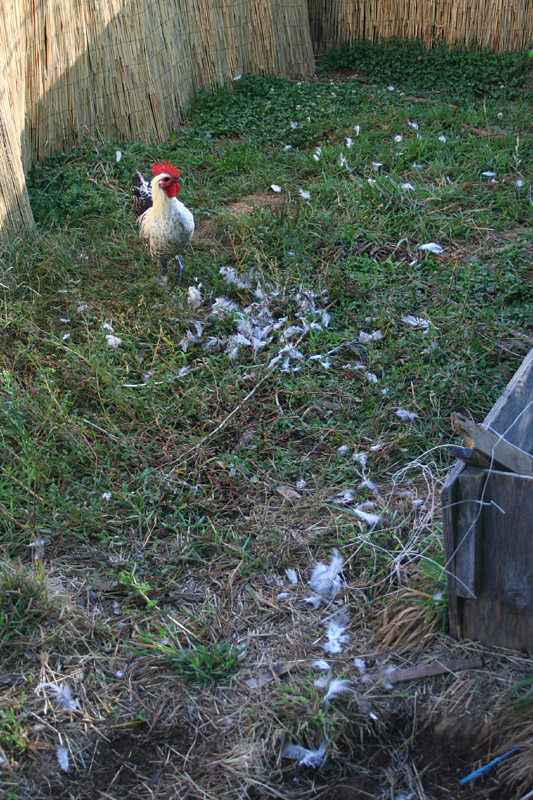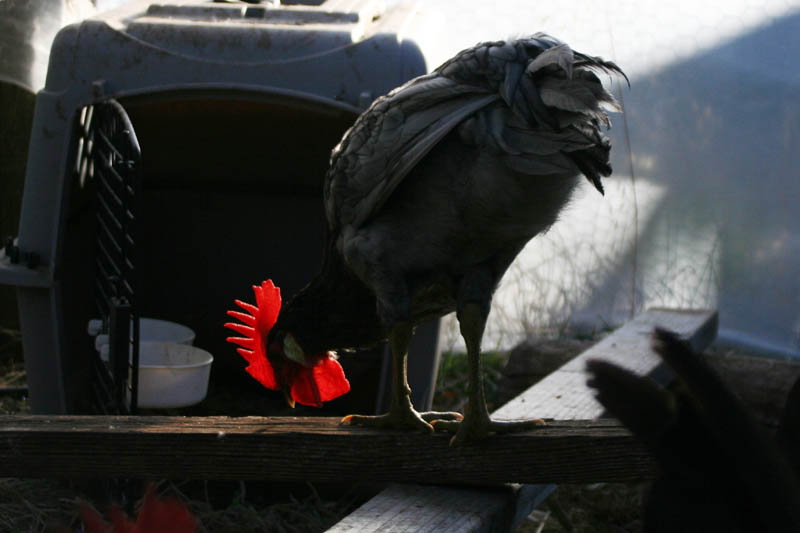I got a little worried when my first chicken stared to look funny around the head and neck. So I went online to find information on it. Here are some of those pages/posts and links.
Economically, plumage deterioration results in increased food consumption and hence less efficient egg production. Thus a substantial improvement in plumage condition will be of appreciable economic value to the producer.
Table 1 summarises the various causes of feather loss, identifying the prime factors involved and the remedy required.
Moulting
This is a physiological phenomenon, which consists of the shedding of existing feathers, followed by replacement with new feather growth. It is usually accompanied by a reduction in egg production or even a complete halt.
Natural moulting
Prior to obtaining adult plumage, fowls at several stages during their life undergo a number of moults where the old feathers are replaced by new feathering.
First moult �
when down is replaced by the first juvenile plumage occurring at 6-8 days and ending at 4 weeks.
Second moult �
when the first juvenile plumage is replaced by the second juvenile plumage. This occurs over a number of weeks starting between 7 and 12 weeks of age.
Third moult �
occurs in the hen at 16 to 18 months. This is the ‘moult’ of most importance for producers.
In the laying hen, natural moulting occurs at the time of year when the days are getting shorter, ie. from January to June. Hormones secreted by the thyroid gland determine the course of the moult. The use of artificial lighting to maintain a constant daylength can be used to avoid this natural moult. This occurs principally by altering the daylength ‘hormone-clock’ within the bird.
Moult characteristics
Male birds moult before females. Shedding is first observed in the feathers of the head and neck, then those of the breast and finally of tail and wings. Moults can be partial (occurring on particular body parts) or complete. The extent of moulting depends upon the breed and the individual bird. The length of the moult is variable, poor layers reconstitute their plumage in 6-8 weeks while good layers following a pause in laying can replace their feathers in 2-4 weeks.
Physiologically, the stop in egg production allows more dietary protein to become available for production of feathers which are primarily proteins themselves. Oestrogen, a hormone released during egg production, retards feather formation. Cessation of lay reduces oestrogen levels so that feather formation is enhanced.
Induced – paused (forced moult)
This is a management strategy to extend the economic life of layer flocks. It principally involves feeding whole grain barley or oats for 5-21 days depending on the required length of the subsequent laying period. The strategy has advantages in rejuvenating egg production, improving internal quality (raises Haugh units) and shell quality in older birds. During the induced – pause, laying can stop with some feather loss occurring.
Vices
Feather-pecking
Feather loss can be caused by vices such as feather-pecking. Once established it is difficult to control and prevention is the best remedy. Social order pecking occurs primarily at the head and is not severe. Severe feather pecking due to overcrowding, lighting problems and unbalanced diets will hurt the bird.
Cannibalism
With feather-pecking any subsequent injury with drawing of blood will attract further pecking leading to cannibalism. To prevent cannibalism it is best to isolate the sick or victim bird from the flock or cage. The injured bird should have cuts treated with antiseptic powder and the wound should be coloured with a dark food dye or Stockholm tar to reduce further pecking attacks by other birds. Alternatively the victim birds can be dusted with a repellent. Beak-trimming or purchase of beak-trimmed stock will reduce the likelihood of feather-pecking and cannibalism especially if problems associated with lighting, stocking density and nutrition have been corrected. In addition it has been observed that some breeds of birds are more likely to feather-peck than others.
Wear and tear
Abrasion
Feather loss is also caused by rubbing against other birds or surroundings, particularly if the birds are closely confined. To reduce feather loss stocking densities should be lowered and all sharp and rough surfaces in a cage eliminated. Alternative cage materials may also assist, in that feathers wear away at different rates when mechanically rubbed against different types of cage materials.
Mating
During mating the hen may lose feathers by the rooster treading the hen. The feathers are torn from the hen’s back by the rooster’s claws. To reduce this feather loss the rooster’s claws need to be trimmed with nail clippers. The rooster’s spurs can be trimmed to about 1.5 cm in length with secateurs.
Stress
A number of factors act as stressors which can contribute to a cessation of egg production and the onset of a moult. Generally a lack of food or water is the most frequent stress causing feather loss. Poorly balanced diets or mouldy feed can also bring on moulting. Lack of cool, clean water even for a short time can cause birds to moult. To minimise this an emergency backup water-supply is advisable. Feather loss can also be caused by chilling, overheating and poor ventilation. A good housing environment will eliminate temperature extremes and still provide good ventilation for the birds. Ill-health either from injury, disease, parasitism or bullying may also contribute to moulting. Medication and regular monitoring of birds will minimise stress and reduce further feather loss.
Table 1. Prime causes of feather loss and their remedy
Cause of feather loss and Prime factos involved = Remedy
Moulting
Natural molt � Decreasing day length from January to June = Maintain constant day length by use of artifical lighting with adequate wattage
Induced molt � pause molt � Feeding whole grain barley or oats = A management strategy; return toa balanced diet
Vices
Feather picking � Social order = Occurs ususally at the head, no treatment is required unless severe
Severe Feather picking � severe pecking due to overcrowding, strong lighting or dietary imbalances = occurs at other body parts, prevention is the best remedy. This is attained by providing adequate lighting, continuous access to balanced diets and reduction in overcrowding. Change bred of bird used. Isolate victim birds, provide antispetic treatments for cuts. Color wound with dye, not red as it attracts further pecking. Beak trim birds when young. Purchase birds already trimmed
Cannibalism = flow on from pecking
Wear and Tear
Abrasions � Rubbing against other birds or surroundings = Lower stock densities. Use alternatie cage materials. Eliminate all rough and sharp surfaces in pen
Mating � Roosters claws in the hen�s back = Trim roosters claws with nail clippers
Stress
Food � lacck of good food = Provide a balanced diet. Remove old or mouldy food
Water � lack of cool water even for a short period = Always provide access to cool clean water
Climatic environment � Overheating � Chilling � Ventilation = Provide a uniform climatic environment which eliminates temperature extremes while providing adwquate ventilation to reduce ammonia build up
Ill health � parasites, disease, injury, bullying = Eliminate problem with management and medication and monitor affected birds
References and further reading
ANON (1989) ‘Keeping Poultry’ Department of Agriculture Tasmania.
KENT, P (1988) ‘Poultry – household layers’
SAY, RR (1987) ‘Manual of poultry production in the tropics’ CAB International.
To access DPI’s information and services
DPI Call Centre 8 am to 6 pm weekdays: Phone 13 25 23 (Queensland residents); non-Queensland residents phone +61 7 3404 6999; E-mail callweb@dpi.qld.gov.au.
This DPI Note is also published on the DPI’s PrimeNotes CD-ROM. http://www.dpi.qld.gov.au/business/5542.html
Information contained in this publication is provided as general advice only. For application to specific circumstances, professional advice should be sought. The Department of Primary Industries Queensland has taken all reasonable steps to ensure the information in this publication is accurate at the time of publication. Readers should ensure that they make appropriate inquiries to determine whether new information is available on the particular subject matter.
another one
Moulting – how, when and why chickens moult
During autumn, many household poultry keepers, particularly people keeping poultry for the first time, are puzzled because egg production markedly declines or ceases despite their laying birds appearing healthy. This seasonal decline in egg production occurs when birds go into a condition known as the ‘moult’.
Moulting is the process of shedding and renewing feathers. During the moult, the reproductive physiology of the bird has a complete rest from laying and the bird builds up its body reserves of nutrients.
The provision of new feathers or a coat (a feature inherent in most animals) is a natural process, designed by nature to maintain a bird’s ability to escape enemies by flight and better protect against cold winter conditions.
Under usual conditions, adult birds moult once a year. Some may moult twice in one year and, rarely, once in two years.
The pullet
The chick goes through one complete and three partial moults during its growth to point of lay. Generally, complete moulting occurs from 1-6 weeks of ag, and partial moulting at 7-9 weeks, 12-16 weeks and 20-22 weeks. During this final moult, the stiff tail feathers grow.
The laying hen
Mature birds normally undergo one complete moult a year, usually in autumn. However, this can depend on the time of the year that the bird started laying. Natural moulting usually begins sometime during March or April and should be completed by July when egg production recommences. The three main factors that bring about moulting are:
- physical exhaustion and fatigue
- completion of the laying cycle (as birds lay eggs for a certain period of time)
- reduction of the day length, resulting in reduced feeding time and consequent loss of body weight.
Eleven months of continuous production is expected from pullets hatched in season. So if a flock of pullets commences laying in March at six months of age, they should continue laying until the following February, although an occasional bird may moult after laying for a few weeks. However, these few birds should begin laying again after June 22 (the shortest day of the year) and continue in production until the following autumn. Pullets coming into lay in June should lay until the following April, giving 11 months of continuous egg production without the aid of artificial light. Pullets coming into lay in spring (August) should lay well into April (nine months); however, unless artificial lighting is provided, most of them will moult during May and June.
Moulting and nutrition
If a bird stops laying and moulting, this means its physical condition is deteriorating and, therefore, cannot support egg production, continued nourishment of their feathers or body maintenance. Feathers contain protein and are more easily grown when laying ceases because of the difficulty in assimilating sufficient protein for both egg and feather production. During the moult, the fowl still needs a considerable amount of good quality food to replace feathers and build up condition.
Good layers and moulting
The time at which a laying hen ceases production and goes into moult is a reliable guide as to whether or not the hen is a good egg producer. Poor producing hens moult early (November-December), and take a long time to complete the process and resume laying i.e. they ‘hang’ in the moult and are out of production for six to seven months. Poor producers seldom cast more than a few feathers at a time and rarely show bare patches.
High-producing hens moult late and for a short period (no more than 12 weeks), and come back into production very quickly. Rapid moulting is seen not only in the wing feathers of good producers, but also in the loss of body feathers generally. Because of this, it is common to see a late and rapid moulting hen practically devoid of feathers and showing many bare patches over its body.
The moulting process

- Figure 1. The moulting process
Moulting takes place in a particular order. Feathers are confined to definite tracts or areas of the body surface, with bare patches of skin between. The first plumage is lost from the head and neck, then from the saddle, breast and abdomen (body), then from the wings and finally from the tail.
When the first feathers drop from the neck and body, good layers often keep laying. However, when the wing feathers begin to drop, laying usually ceases.
The main wing feathers comprise 4 tiny finger feathers on the extreme tip of the wing, 10 large primary or ‘flight’ feathers, a small axial feather and 14 secondary feathers, which are smaller and softer than the primaries.
When the wing moults, primary feathers are shed first from the axial outwards to the end of the wing. Then the secondaries are shed, though not in such a set order as the primaries. The number one primary feather is the first to drop, followed by a number two and then in order to number 10. While the primaries are shed, the secondaries begin to drop.
The axial feather drops at the same time as the secondary next to it. A new quill starts to grow as soon as the old feather is out, and takes approximately six to seven weeks to grow. The moult is complete when all primary flight feathers on the wing have been replaced. The feathers of the moulted bird are larger, fuller, softer, cleaner, brighter and glossier than the previous feathers, which were small, hard, dry, frayed and tattered.
The difference between a rapid and slow moulter is not a difference in the growth rate of the individual feather, but the fact that the rapid moulter renews a large number of feathers at the same time. With this knowledge, the rate of moulting can be ascertained by examining the number of flight feathers on the wing being replaced simultaneously. If a hen is found to have grown some of her primaries before starting to moult her secondaries, it may be assumed that she laid well into the moult and was therefore a good layer.
Sometimes, high producing hens do not moult all their primary feathers but carry them on for another year. Generally, a layer moults when production ceases; although, if the bird has an inherited tendency for high production, moulting will probably precede cessation of production, and conversely if she is a poor producer. Modern laying breeds should moult in late autumn because they have been bred specifically for egg production, i.e. to lay at a higher rate and for a longer period of time.
A laying bird that lays regularly usually retains old feathers. If a hen ceases production for any reason other than mild sickness or broodiness, it loses its feathers.
If a hen ceases production during spring or summer, it may moult one or two primaries and then stop moulting, and come into lay again. This is known as a vacation moult. When the hen starts its full moult later in autumn, it drops the next feather in sequence and moults in order of the remaining primaries.
A bird may sometimes experience a neck or partial moult without any loss of production. However, if the moulting extends beyond the neck moult stage, the hen ceases production.
The presence of ‘pin’ feathers (new emerging feathers) usually indicates a short or partial moult.
Some birds moult continuously and can be easily detected in the flock by the spotless condition of their new feathers. These birds are poor producers and should be culled.
Stress factors and moulting
Natural moults can occur any time of the year if birds are subjected to stress. A bird becomes stressed when the environment or management presents a challenge to which the bird cannot respond without suffering a harmful effect. If a hen is subjected to a mild stress condition in late spring when in full production, she will suffer a drop in egg production; whereas, if a hen is subjected to the same stress condition in autumn, it will cease laying and moult.
Common stress factors that can induce moulting include disease, temperature extremes, poor nutrition, predators and poor management. These are discussed in more detail in a separate article (see Further reading below).
Production and moulting
After moulting, birds in their second year of egg production will produce 10-30 per cent less than in their first year of lay, as the lay rate is lower and the birds cease to lay earlier in the following autumn. Birds that have moulted twice and are laying for their third year produce only 70-80 per cent of their second year’s eggs (about 60 per cent of their first year’s production).
Moulting cockerels
Cockerels also moult and, while in this condition, are nearly always infertile because they have lost weight and their reproductive physiology is in a resting phase. Care must be taken to ensure that cockerels do not lose more than 25 per cent of their body weight while moulting, as this can lead to sterility.
Advantages and disadvantages
The four main advantages of keeping hens during the moult and the following year are that:
- it is cheaper to carry a bird through a moult than buy replacement pullets
- fewer replacement pullets may be needed and buying can often be deferred, which means saving money, time and transport
- moulted birds are hardier and not as prone to disease
- only high-producing, efficient birds will be retained if strict culling is undertaken during the first year.
The main disadvantage of keeping the hens is that, although moulted birds eat less feed than pullets, they lay less eggs. Overall, their conversion of feed into eggs – and feed cost per dozen eggs – is higher.
Other disadvantages are that:
- during the moult, they continue to eat but remain unproductive
- they are not as tender to eat if they are slaughtered for the table after two years of laying
- too few birds may be retained to provide sufficient eggs the following year.
Year-round laying and moulting
Year-round egg production can be achieved through the purchase of pullets in autumn at point-of-lay. This provides sufficient eggs while the older birds are moulting. When the pullets’ rate of lay declines in the summer, the additional eggs from the moulted birds should sustain an adequate supply. The following autumn, the older birds can be slaughtered for the table, the best pullets can be allowed to moult, and another lot of pullets on point-of-lay can be purchased. This allows for 20 per cent pullet wastage due to deaths and culling. Only 70 per cent of the normal pullet requirements need to be purchased and, at the same time, a relatively constant year-round supply of eggs is guaranteed.
Acknowledgment
This article is derived from the Western Australian Department of Agriculture Farmnote 3/79, January 1979, and is used with permission.
feather loss:
http://www.daff.qld.gov.au/27_2704.htm
 Not a new nest, the eggs at least did not look freshly laid – and I knew – that buff that went missing a few weeks ago – that was her, she was broody with a mind of her own after all. If I had not seen a splash foraging about in that area and was making sure she was no longer there – it would have been a long time before I found them.
Not a new nest, the eggs at least did not look freshly laid – and I knew – that buff that went missing a few weeks ago – that was her, she was broody with a mind of her own after all. If I had not seen a splash foraging about in that area and was making sure she was no longer there – it would have been a long time before I found them.




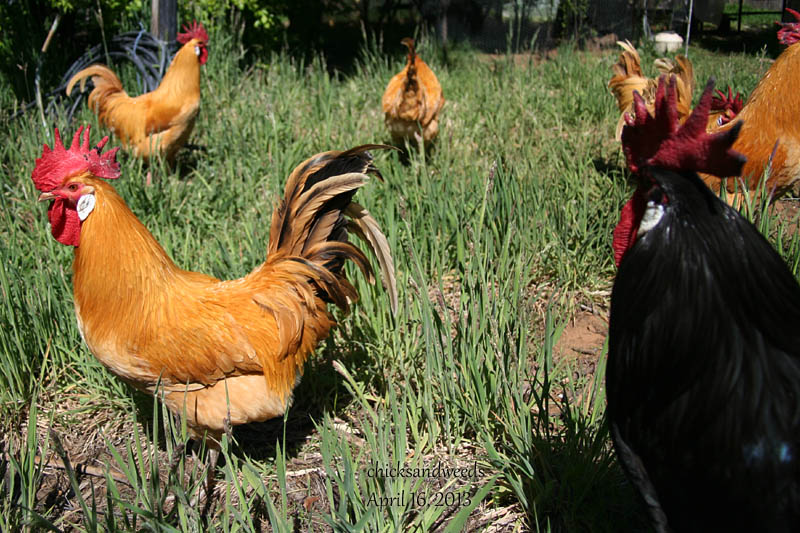
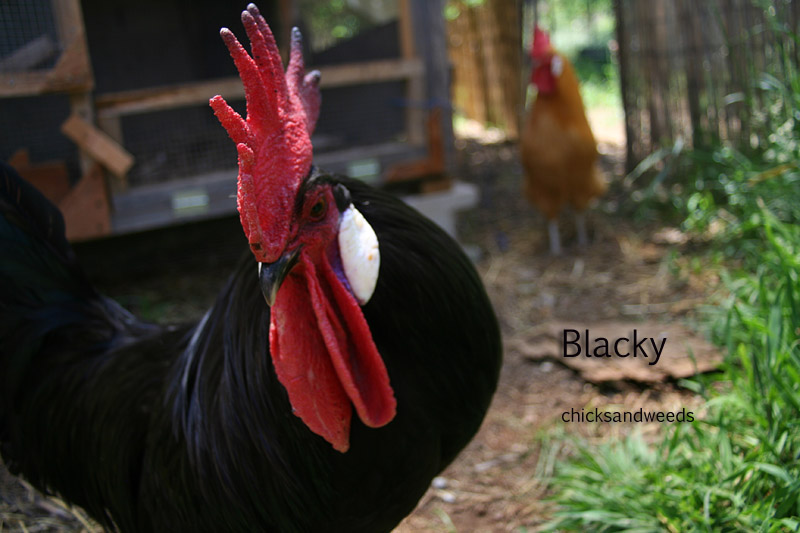







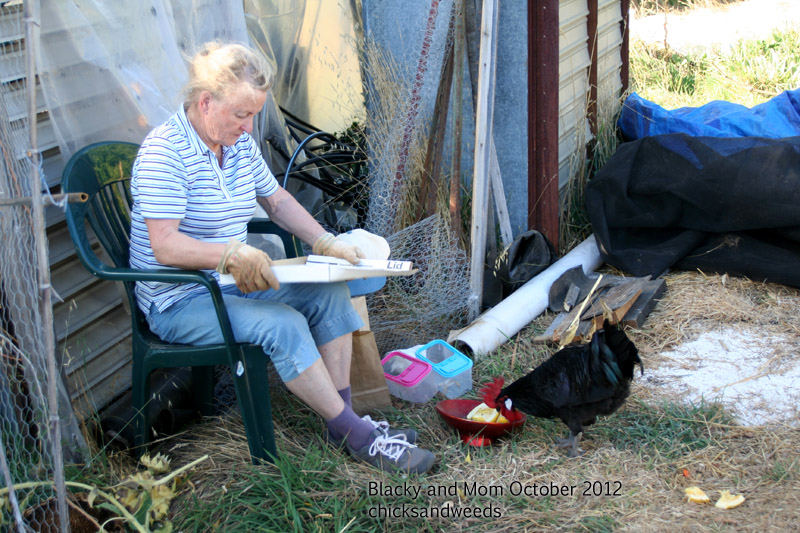
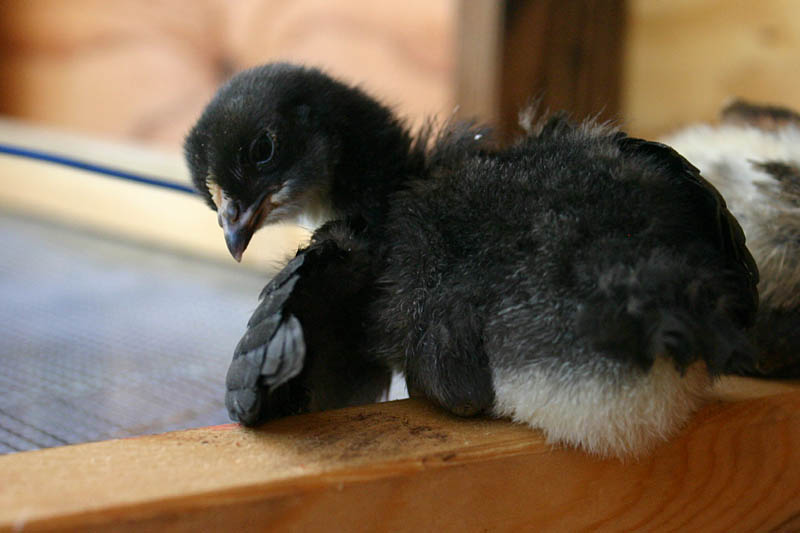




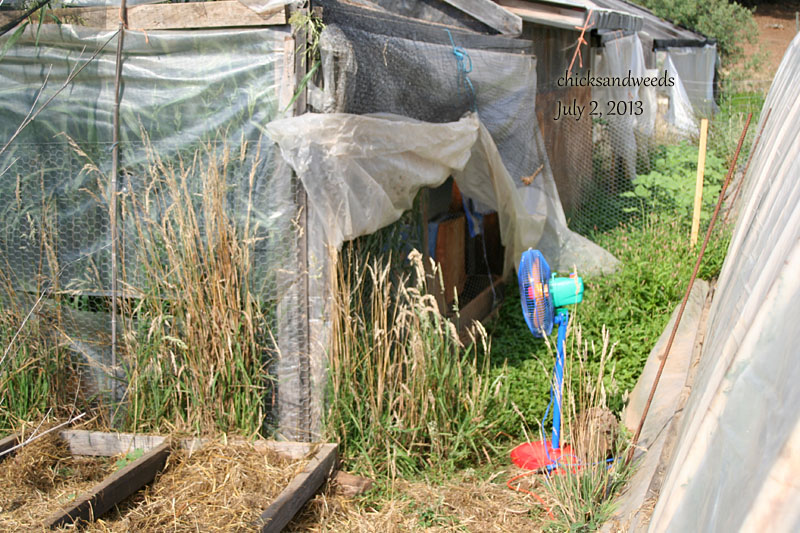
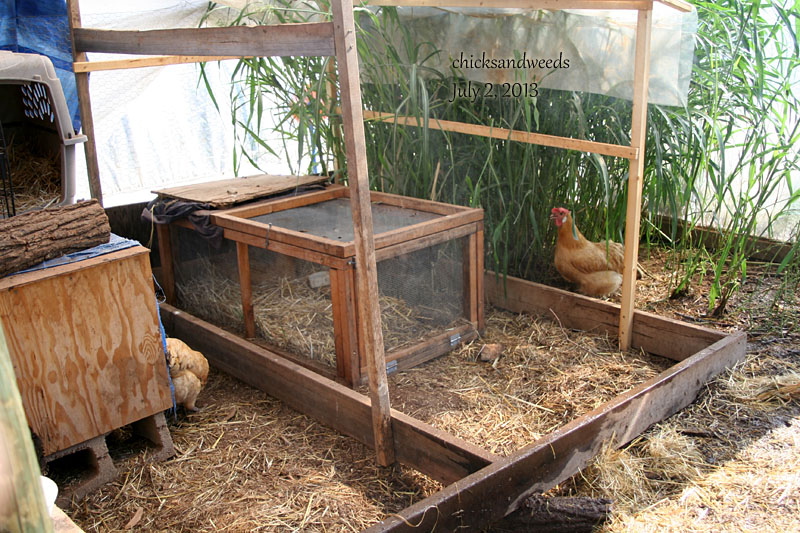


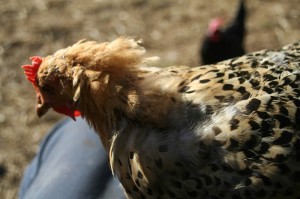









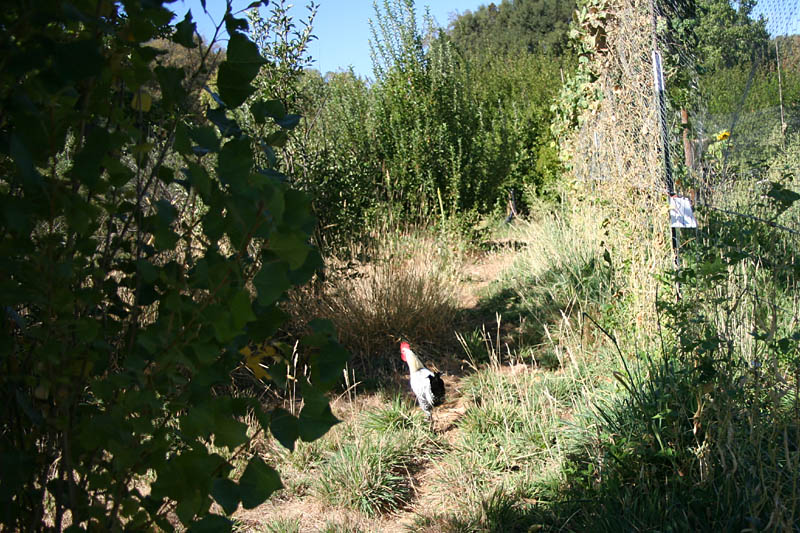
 This is about 2 roosters, and their feathers after a night in the tree and life and death and what we don’t know. So if you were looking for info on rooster feathers or some such thing – this is not it.
This is about 2 roosters, and their feathers after a night in the tree and life and death and what we don’t know. So if you were looking for info on rooster feathers or some such thing – this is not it.